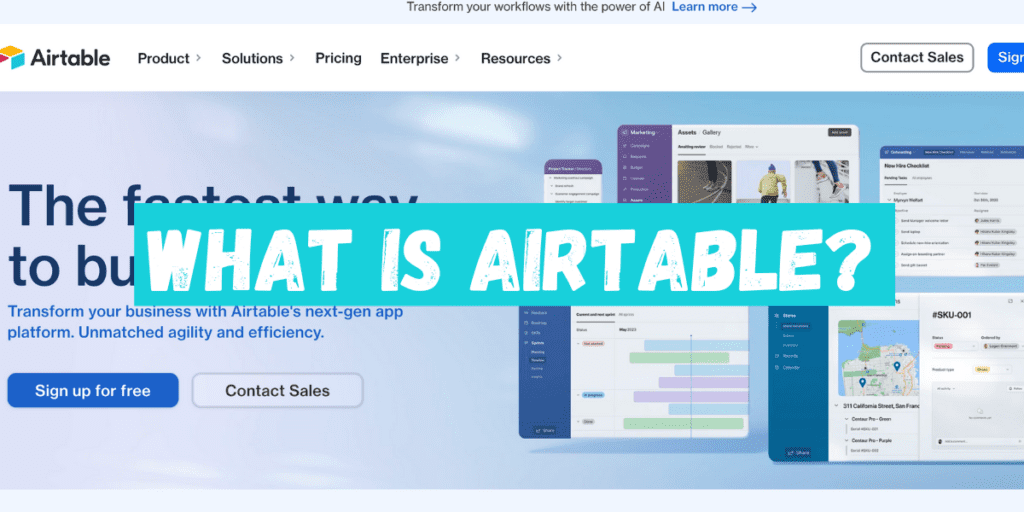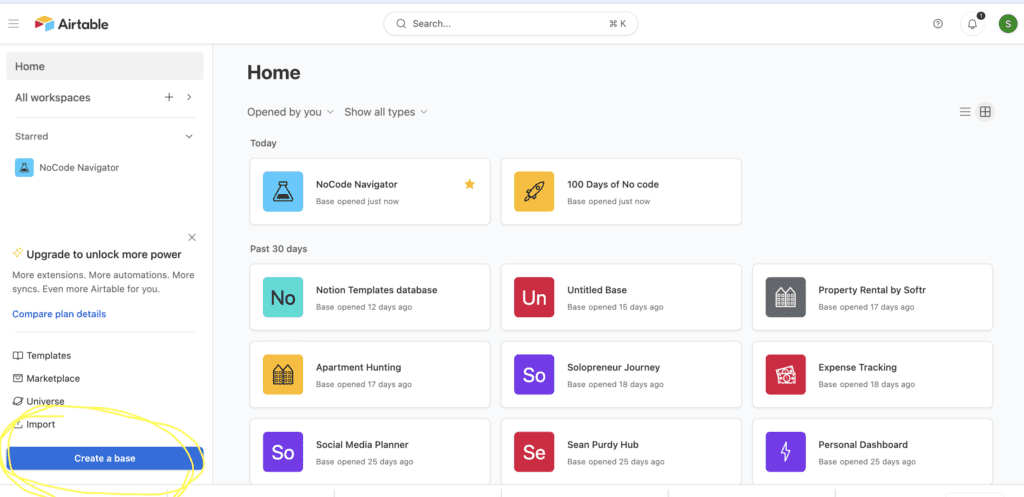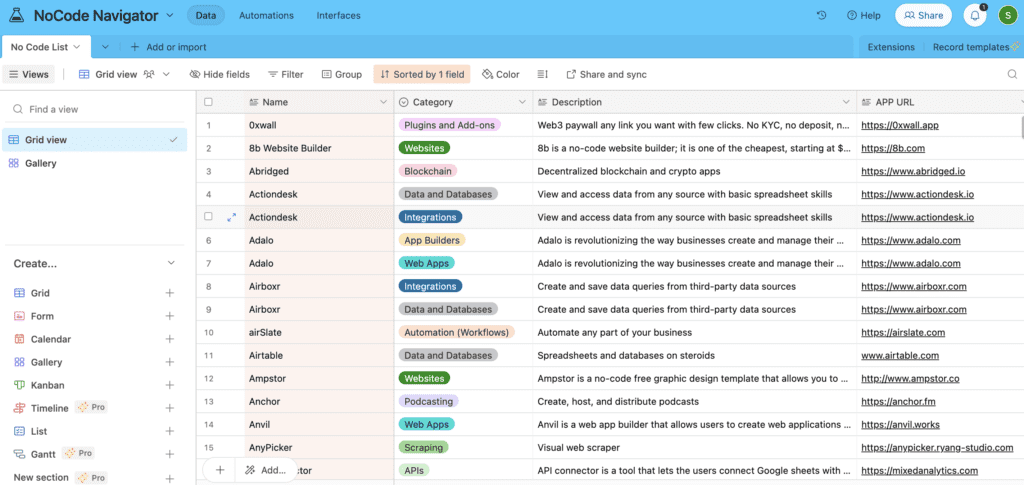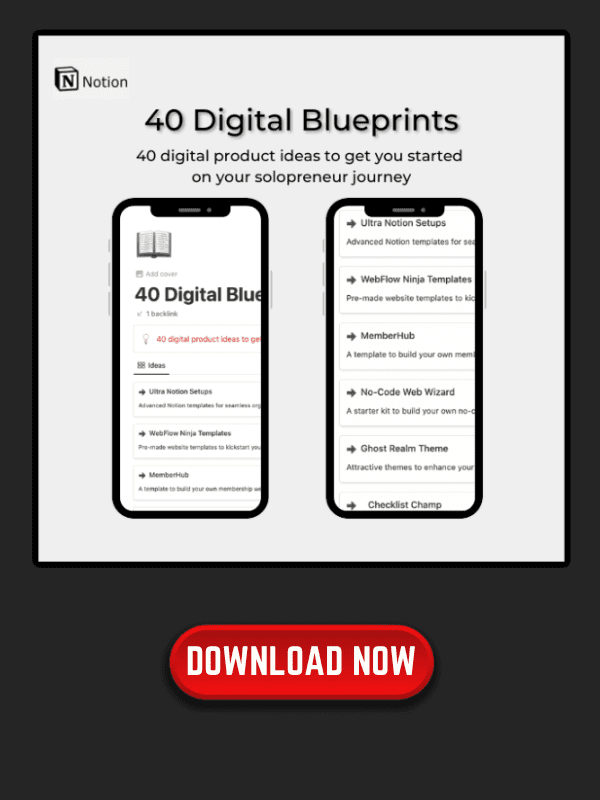Airtable No Code Tool
Are you tired of using multiple tools to manage your projects, clients, and data? Do you wish there was a more efficient way to organize everything in one place? Look no further than Airtable, the ultimate no-code tool designed for ambitious professionals, aspiring consultants, and no-code creators who want to improve the way they work and play.
Airtable’s flexibility means it can replace most of the tools you use today. With its intuitive spreadsheet-like interface, you can create custom databases, track tasks, manage projects, and collaborate with your team all in one place. Whether you’re a freelancer, small business owner, or part of a large corporation, Airtable can help you streamline your workflow and increase productivity.
In this ultimate guide to Airtable, we’ll take you through everything you need to know to get started, including what Airtable is, how to use it, its integrations with other tools, and how it compares to other similar tools on the market. By the end of this guide, you’ll have a clear understanding of how Airtable can benefit you and your business, and how to leverage its power to improve your workflow and productivity.
Key Takeaways
- Airtable is a flexible no-code tool that can replace most of the tools you use today.
- With Airtable, you can create custom databases, track tasks, manage projects, and collaborate with your team all in one place.
- By leveraging Airtable’s power, you can streamline your workflow and increase productivity.
What is Airtable?

If you’re looking for a no-code tool that allows you to create and manage databases, Airtable might be the perfect solution for you. Airtable is a cloud-based platform that combines the functionality of a spreadsheet with the power of a database. It’s a simple, yet powerful tool that can be used for a variety of purposes, from project management to content marketing.
Overview
Airtable is often compared to Google Sheets or Microsoft Excel, but it’s much more than that. It’s a flexible and comprehensive tool that allows you to create custom databases, manage workflows, and automate tasks without any coding skills. You can use it for a wide range of use cases, from managing your sales pipeline to tracking your inventory.
Features
Airtable has a wide range of features that make it a great tool for managing data. Some of the key features include:
Templates: Airtable offers a variety of templates that you can use to get started quickly. There are templates for project management, content marketing, inventory management, and more.
Views: Airtable allows you to create different views of your data, including grid view, calendar view, and kanban view. This makes it easy to visualize your data and manage it in a way that works best for you.
Integrations: Airtable integrates with a wide range of tools, including Zapier, Slack, and Mailchimp. This allows you to automate tasks and streamline your workflows.
Automations: Airtable allows you to create automated workflows that can save you time and reduce errors. You can set up triggers and actions to automate tasks like sending notifications or updating records.
Benefits
Airtable offers a number of benefits that make it a great tool for managing data. Some of the key benefits include:
Flexibility: Airtable is a flexible tool that can be used for a wide range of purposes. You can customize it to fit your specific needs and workflows.
Functionality: Airtable offers a wide range of functionality, from simple data management to complex automations. It’s a powerful tool that can help you streamline your workflows and save time.
Marketplace: Airtable has a marketplace where you can find pre-built apps and integrations that can help you extend the functionality of the platform.
Sync: Airtable allows you to sync your data with other tools, like Google Sheets or Excel. This makes it easy to manage your data across different platforms.
Enterprise: Airtable offers an enterprise plan that includes additional features like single sign-on and audit logs. This makes it a great tool for larger organizations.
Overall, Airtable is a great tool for anyone looking to manage data without any coding skills. It’s simple, powerful, and flexible, making it a great choice for a wide range of use cases. Whether you’re a beginner or an experienced user, Airtable has something to offer.
How to Use Airtable
Airtable is a simple yet powerful no-code database tool that can be used for a variety of purposes, from project management to content marketing. In this section, we’ll cover how to use Airtable to create a database, add data, create views, and automate workflows.
Creating a Base

To get started with Airtable, you’ll need to create a base. A base is essentially a database, and you can create one from scratch or use one of the many templates that Airtable provides. Templates are a great way to get started quickly, and you can choose from a variety of different categories, including sales, inventory management, and content marketing.
Adding Data

Once you’ve created a base, you can start adding data. You can do this manually by entering data into individual cells, or you can import data from a CSV file or another data source. Airtable also provides forms that you can use to collect data from others, such as customers or team members.
Creating Views

Views are a powerful feature of Airtable that allow you to see your data in different ways. You can create different views for different purposes, such as a Kanban view for project management or a Gantt chart view for tracking timelines. You can also filter your data and sort it by different criteria.
Automating Workflows
Airtable provides a variety of integrations and automations that can help you streamline your workflows. For example, you can use Zapier to automatically create new records in Airtable when a new lead is added to your CRM. You can also use Airtable’s built-in automations to send automated notifications or update records based on certain criteria.
In conclusion, Airtable is a comprehensive and flexible no-code tool that can be used for a variety of use cases. Whether you’re a beginner or an experienced user, Airtable’s simple interfaces and powerful capabilities make it a great choice for data management, project management, and more. With its extensive documentation and active community, learning Airtable is easy and straightforward.
Try it out for yourself with Airtable’s free trial and see how it can help you streamline your workflows and automate your data management.
Airtable Integrations
Airtable is a powerful no-code database tool that allows you to create different workflows, views, and templates for your projects. With its simple and flexible functionality, it offers a lot of use cases for businesses of all sizes. One of the most significant benefits of Airtable is its ability to integrate with other tools, which can streamline your workflow and automate many processes.
Zapier
Zapier is a popular integration tool that allows you to connect Airtable with over 2,000 other apps. With Zapier, you can automate your workflows by creating “Zaps” that trigger actions in Airtable based on events in other apps. For example, you could create a Zap that automatically adds new rows to your Airtable base when a new lead is added to your CRM.
Make
Make is another integration tool that works similarly to Zapier. It offers a comprehensive platform for automating your workflows with Airtable, including the ability to connect to over 500 apps. With Make, you can create complex workflows with conditional logic, filtering, and data manipulation.
Automate.io
Automate.io is a no-code integration tool that specializes in automating sales and marketing workflows. It offers pre-built templates for connecting Airtable with other apps like Mailchimp, Stripe, and Hubspot. With Automate.io, you can create workflows that automate your sales process, send automated emails, and more.
Other Integrations
In addition to Zapier, Make, and Automate.io, Airtable also offers many other integrations through its marketplace. Some of the most popular integrations include Google Sheets, Microsoft Office, and Stripe. With these integrations, you can sync data between Airtable and other tools, edit tables directly from other apps, and more.
Overall, Airtable’s integrations and automations capabilities make it a powerful tool for project management, workflows, and data management. With its flexibility and functionality, it’s an excellent option for businesses of all sizes.
Airtable vs. Other Tools

When it comes to choosing a no-code tool, Airtable stands out as a versatile and powerful option. However, it’s important to consider how it compares to other tools in the market. Here’s a breakdown of how Airtable stacks up against other popular tools.
Google Sheets
Google Sheets is a widely used spreadsheet tool that offers basic database capabilities. While it’s a good option for simple projects, it lacks the advanced features and flexibility of Airtable. Airtable’s ability to link records across tables, use rich media, and support custom views makes it a more powerful tool for complex projects.
Excel
Excel is another popular spreadsheet tool that has been around for decades. While it’s a powerful tool for data analysis, it lacks the collaborative capabilities and ease of use of Airtable. Airtable’s intuitive interface, drag-and-drop functionality, and real-time collaboration features make it a more user-friendly option.
Other Spreadsheet Tools
There are many other spreadsheet tools on the market, but few offer the database capabilities and flexibility of Airtable. While some tools may have similar features, Airtable’s ability to handle complex relationships and automate workflows sets it apart.
Trello
Trello is a popular project management tool that uses a visual board to organize tasks. While it’s a good option for simple projects, it lacks the database capabilities and customization options of Airtable. Airtable’s ability to create custom views, use rich media, and automate workflows makes it a more powerful tool for complex projects.
Asana
Asana is another popular project management tool that offers more advanced features than Trello. However, it lacks the database capabilities and customization options of Airtable. Airtable’s ability to handle complex relationships and automate workflows makes it a more powerful tool for managing projects with multiple stakeholders.
Notion
Notion is a newer tool that combines note-taking, project management, and database capabilities. While it’s a good option for personal use or small teams, it lacks the advanced database features and automation capabilities of Airtable. Airtable’s ability to handle complex relationships and automate workflows makes it a more powerful tool for managing large projects.
Monday.com
Monday.com is a popular project management tool that offers similar features to Airtable. However, Monday.com lacks the advanced database capabilities and customization options of Airtable. Airtable’s ability to handle complex relationships and automate workflows makes it a more powerful tool for managing complex projects.
Overall, while there are many other tools on the market, Airtable stands out as a versatile and powerful option for managing complex projects. Its advanced database capabilities, custom views, and automation features make it an ideal tool for teams of all sizes.
Conclusion
Congratulations! You have now completed the ultimate guide to Airtable, the most powerful no-code tool available. With Airtable, you can streamline your workflow, automate your tasks, and create custom applications that meet your specific needs.
By now, you should have a good understanding of what Airtable is, how it works, and how you can use it to improve your productivity. You have learned about the various features and functionalities of Airtable, including the different types of fields, views, and blocks.
You have also discovered how Airtable can be integrated with other no-code tools, such as Zapier and Integromat, to create powerful automations. Additionally, you have seen how Airtable can be used to build custom applications and databases that can be shared with your team or clients.
Overall, Airtable is a versatile and powerful tool that can be used in a variety of ways. Whether you are a freelancer, a small business owner, or a large corporation, Airtable can help you streamline your workflow and increase your productivity.
So what are you waiting for? Start using Airtable today and see how it can transform the way you work. With its intuitive interface, powerful features, and endless possibilities, Airtable is the ultimate no-code tool that you don’t want to miss out on.




